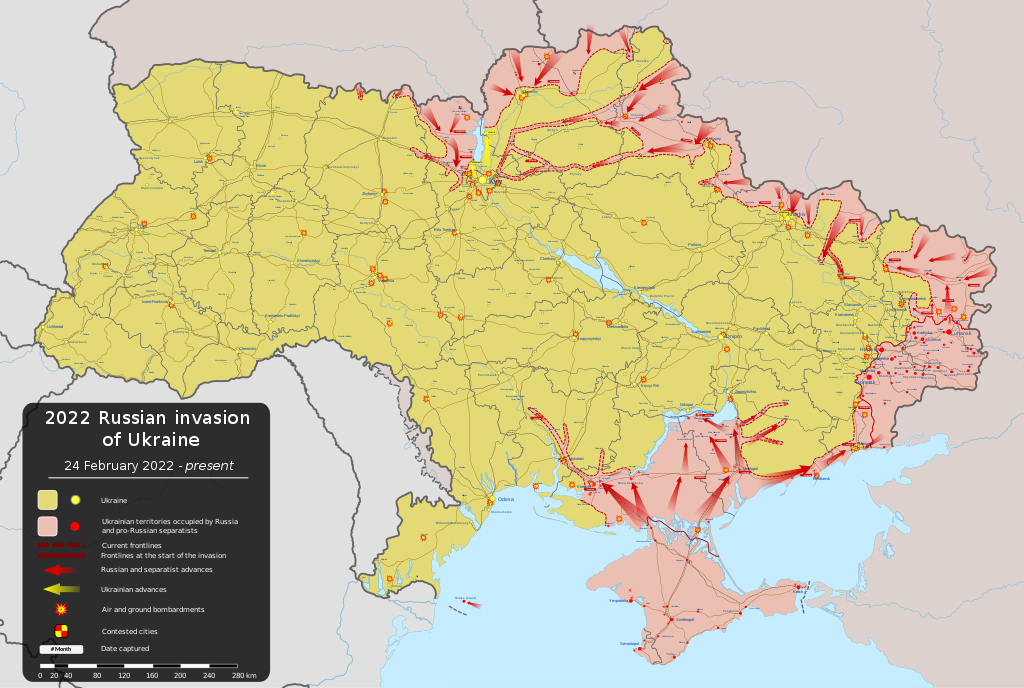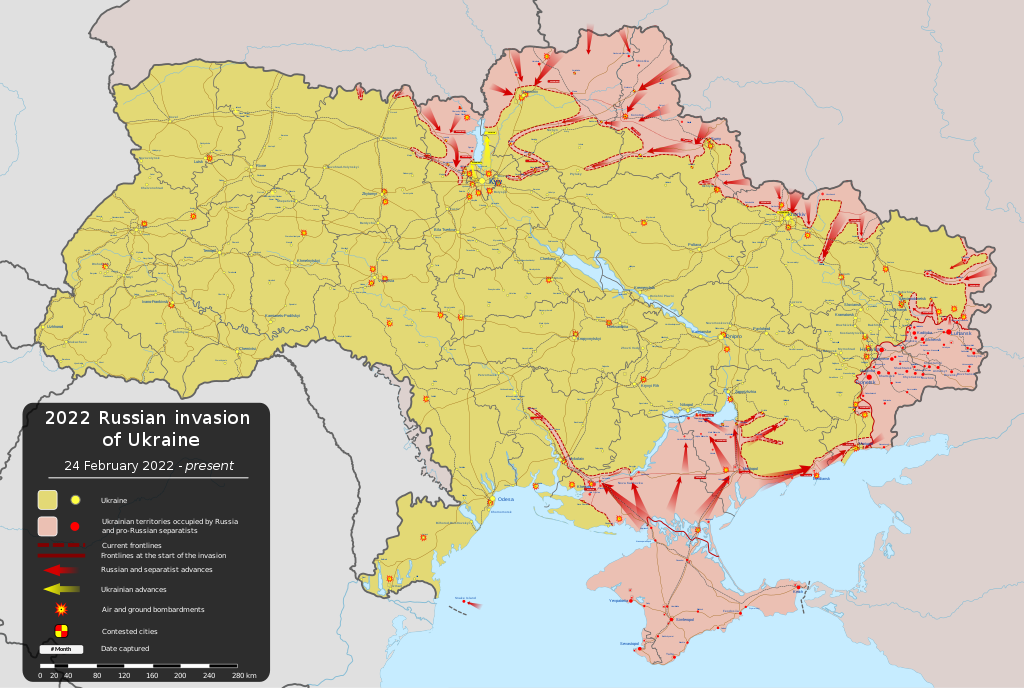
Not much movement on the ground, but it does look like some serious fights the last couple of days around Mikolaiv and Kharkov. Front line trace is not moving much. I will put the updated sections of this daily post in italics.
No real change for like the ninth day in the row. Shelling and missile strikes in and around Kiev and Kharkov, but no fighting in the cities that we are aware of. Russia continues to occupy three cities, Berdyansk (pop. 107,928), Melitopol (pop. 150,768) and Kherson (pop. 283,649).
There was a sense that Russia was moving up forces on Kiev and Kharkov to either isolate or assault these cities. So far neither has happed at either city. Russian tanks are being reported in the suburbs west of Kiev, at Irpin.
They have isolated Mariupol. The city has been without power since 1 March. I gather the Russian forces in that area are not overwhelming. Not sure they have the strength to take it or will try. Instead, it appears that they are going to try to starve it out. The vice-mayor said on the morning of 3 March on CNN that they could hold out for five days. This is now a city far enough away from the other fighting grounds, that I assume there will no real attempt to relieve it.
So, it does appear that this is the first “siege” of the campaign. Is the future of the Russian offensive? Is the next one at Kharkov?
We are looking six major areas of operations right now.
1. Kiev
2. Odessa
3. Kharkov
4. The Donetsk and Lugansk provinces
5. Mariupol
6. Crimean border/Kherson
Here is what I have heard/seen from open sources:
1. Kiev (pop: 2,962,180): The reinforced Russian Army is in the northern outskirts of Kiev (the Obolon district). They have also occupied the defunct nuclear power plant at Chernobyl and the large Antonov/Hostomel airport north of Kiev. They appear to be at the northern and eastern outskirts of the city. At one point they were within four miles from the center of the city. Russian tanks are being reported in the suburbs west of Kiev, at Irpin. The center of the city appears peaceful.
Ukrainian President Volodymyr Zelenskyy remains defiantly in Kiev. I gather the city is still open to the south.
Chernigov (pop. 285,234) it located to the NNE of Kiev. The Russians have pushed columns past the city and down to Kiev, but the city remains under Ukrainian control. It is reported that all exits from the city have been mined. There have been some Russian tank and jet aircraft losses around this area.
2. Odessa (pop: 1,015,826): Appears to be safe and secure for now. Continue to see news reports (CNN and France 24) of the locals building up the defenses there. They did damage (sink?) a 1300-to-1700-ton patrol vessel yesterday: Vasily Bykov
3. Kharkov (pop: 1,433,886): Kharkov is being shelled but it does not look like the Russians have tried to re-enter the city.
There was at least one video-based report a couple of days ago of a Ukrainian counterattack outside of Kharkov. I then noted this recent video, which kind of looks like a recent Ukrainian counterattack. See: Welcome to Ukraine S…. This minute long video is definitely worth watching. It shows four tanks abandoned/destroyed, two Lt. Colonels were killed, and at least a half-dozen fuel trucks taken/destroyed. The fight occurred at Chuhuiv, 35 km SE of Kharkov. It is on the map above.
As I suspect that surrounding and besieging Kharkov will be the next major objective of the Russian Army after they take Mariupol, I do consider this significant. The question is, is it significant enough to keep Kharkov from being encircled.
Sumy (pop. 259,660) looks in danger of being isolated. The Russians have taken Konotop (pop. 84,787).
4. The Donetsk and Lugansk provinces: So far, we have not heard much from this area. We do have a casualty report dated 7 March from the Donetsk People’s Republic saying they have 47 soldiers killed and 179 wounded.
5. Mariupol (pop: 431,859): Day 8 of the siege. This city of part of the Donetsk Oblast (province/county) and is on the route to Crimea. Mariupol is partly encircled and the power to the city is down. It appears they are going to keep it isolated and besiege it. The vice-mayor of this city said on 3 March that they can hold out for five days. I do not expect any significant relief columns.
6. Crimea & Kherson (pop: 283,649): Kherson is under Russian control.
Mikolaiv (pop. 476,101), the city on the Southern Bug River just west of Kherson, is still under Ukranian control. There has been a lot of fighting here recently, but it looks like the Ukrainian Army is holding.
The Russians appear to have gained control of a lot of the area just to the north of Crimea. This may be the end of their expansion in this area for now until they take Mariupol.
Russia has taken Zaporizhzhia nuclear power plant, which is making everyone nervous. It is the largest nuclear power plant in Europe.
I will update this post during the day as I find more information.
Ukrainian Army Build-up: According to the Ukrainian defense minister, more have 140,000 Ukrainians has returned and more than 20,000 foreigners from 52 countries have appealed to fight for Ukraine. This includes about 3,000 Americans who have “expressed interest” according to Ukraine. This also includes “up to 500” Indians. I have seen reports of volunteers from places like Thailand and Japan (70 volunteers). All these figures are questionable, we shall see how many actually show up in Lviv. According to Fox News some are being turned away because of a lack of weapons. According to senior U.S. officials, the U.S. and other NATO members have so far sent Ukraine 17,000 AT missiles and 2,000 Stinger AA missiles.
The Russian Home Front: Count of detained protesters is claimed to be over 13,000 since the war began, with at least 4,640 people this Sunday. See: OVD-info. Protests continue. At least 800 people have been detained in Belarus. 11,569 medical professionals have signed a letter protesting the war, using their names, title and affiliation.
Exchange rate: The Ruble has rallied to 117.80 to a dollar as of 8:57 AM EST. Update: Ruble ended the day (4:45 PM) at 144.01, so not that good of a rally. Not sure what the exchange rate will be if Russia ever opens its stock market.
Price of oil (Brent crude): $123.08 as of 8:58 AM EST. The last report I saw, 52% of the Russian government revenue comes from oil (even though it makes up only 7% of their economy). There is a strong desire on the part of the west to bring this price down, as it undercuts their budget.
Casualties: The UN is reporting for 8 March 474 civilians confirmed dead in the war. They previously reported that 23 were in territory controlled by Russian separatists. Ukraine is claiming over 2,000 civilians killed. Ukraine is reporting on 1 March over 110 soldiers killed. Russia is claiming to have captured 572 soldiers (which is entirely believable).
Russia reported on 2 March 498 troops have been killed and 1,597 wounded. This is a 3.21-to-1 wounded-to-killed ratio, which seems a little low (see link below). Ukraine is reporting almost 200 Russians captured. Donetsk People’s Republic is reporting on 7 March that they had 47 soldiers killed and 179 wounded (3.81-to-1 wounded-to-killed ratio). U.S. officials are claiming around 2,000 to 4,000 Russian soldiers killed and 3,000 captured. Have no idea of the validity of the U.S. figures but suspect the Russian casualty figures are understated (because they kind of always are).
Note: Wounded-To-Killed Ratios | Mystics & Statistics (dupuyinstitute.org)
Also see Chapter 15 (Casualties) in War by Numbers.
The twitter account @oryxspioenko is reporting on 5 March 99 Russian tanks have been lost by Russia based upon visual confirmation. For 6 March this is now 116. He is also reporting at this time 10 Russian aircraft shot down in the last 26 hours based upon videos of them being shot, been shot down, or their crews captured. This includes five Su-25s, Su-30s and Su-34 jets. Granted Russian has well over a thousand modern jet aircraft, but it does show that the Ukrainians do have some capability to defend their airspace. I gather as more Stingers and other surface-to-air missiles are received and deployed; this is going to become a more dangerous environment. It may serve to contain Russian air.
Russian Equipment Losses: As of 2100 hours on 7 March, @oryxspioenko is reporting the following Russian losses based upon his analysis of pictures and videos. See: https://www.oryxspioenkop.com/2022/02/attack-on-europe-documenting-equipment.html
Tanks: 141
AFVs: 89
IFVs: 131
APCs: 52
Jet aircraft: 10
Helicopters: 11
Ukrainian Equipment Losses: As of 2100 hours on 7 March, @oryxspioenko is reporting the following Ukrainian losses based upon his analysis of pictures and videos:
Tanks: 46
AFVs: 38
IFVs: 33
APCs: 18
Jet aircraft: 6
Helicopters: 0
Have no idea how accurate this count really is (the Ukrainian losses seem low), but I figure it is probably the best count publicly available.
It is clear that at least 1,500 people have died in this conflict. It may be more like 3,000 deaths. I am not confident in the accuracy of claims like those made by the Ukrainian general staff that more than 11,000 Russian troops were killed in the first 10 days.
There are people doing a better job of this on Twitter, including @RALee85 and @Oryxspioenkop and @caucasuswar, none of whom are known to me.
End of the War: While Ukrainian and Russian delegations are talking, I don’t expect much from this in the short term. Mariupol is supposed to have fallen already. I suspect the Russians will not be interested in negotiating until they have taken it. It is part of the Donetsk province.
Peskov, the Kremlin spokesman, provided four conditions for a cease fire:
- Ukraine ceases military action,
- Change its constitution to enshrine neutrality,
- Acknowledge Crimea as Russian territory, and
- Recognize the People’s Republics of Donetsk and Lugansk as independent states.
The attached map is from Wikipedia giving the “Military situation as of 9 March 2022.” View with caution.




